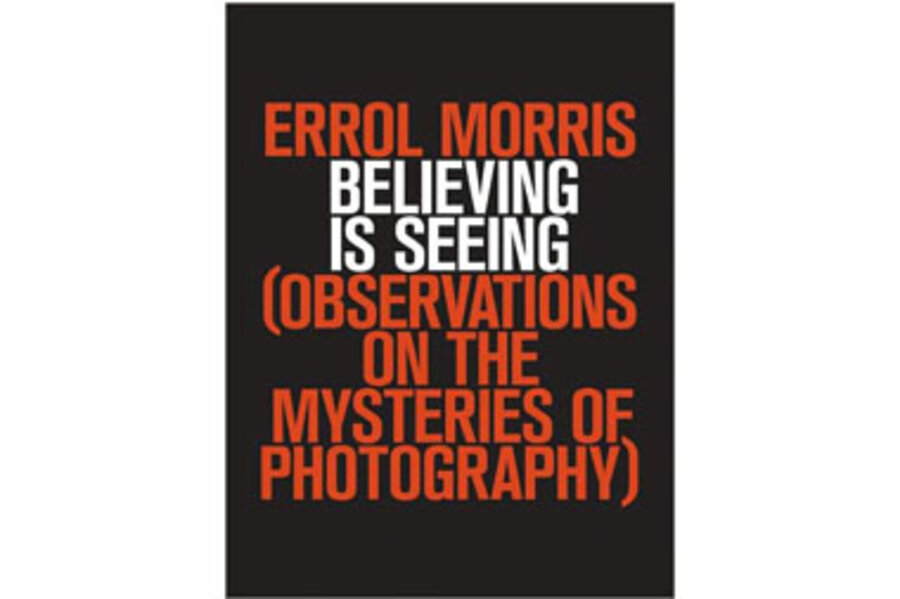Believing Is Seeing: Observations on the Mysteries of Photography
Loading...
At the beginning of Believing is Seeing, an eye-opening book about how images come to have meaning, MacArthur-winning filmmaker Errol Morris reveals that he's got a strabismus, a condition that misaligns his sight. Two eye-images that normally resolve into one unified field of vision are always, for him, slightly separate. For Morris, who literally sees "both ways," sight is never simple. He uses his condition as a jumping-off point for a nuanced exploration of how photographs – especially those we most entrust with showing us truths – simultaneously reveal and conceal. Commenting on now-iconic photographs of soldiers and torture victims at Abu Ghraib, The New Yorker's Seymour Hersh wrote, "the photographs tell it all." But what, asks Morris, are the "it" and the "all"? How is the telling done?
Those who have had the luck to fall under the spell of Errol Morris's films already know what sidelong worlds he documents. Gates of Heaven, a classic from the late 1970s, takes on the subject of pet cemeteries, exploring the odd business of interring our beloved furry dead through the experience of a family who not only runs a pet cemetery but also buries its deceased pets there. The Thin Blue Line, a study in the fragility of human justice, re-enacts a Texas murder case that led to the wrong man spending 12 years in jail. And in the recent The Fog of War, Morris talks to Robert McNamara about the decisions he made as Secretary of Defense during the Vietnam War. The film won the Academy Award for Best Documentary Feature in 2003.
In each film, Morris displays his genius for allowing people to reveal themselves in haunting and muddy complexity. Something as seemingly kooky as watching a family-run pet-burial business turns into a profound meditation on the human search for meaning. Morris manages to take people's banalities, pedantries, and prejudices, and turn them into art. And he does so with a master's touch: Just at the very moment I think I might be bored I find, to my surprise, that I'm actually utterly fascinated.
In this way, Morris can get away with projects that most of us would simply censor ourselves from undertaking. Who else can go to a dusty road in the Ukraine to retrace an impossible-to-solve mystery about the placement of cannonballs during a harrowing but largely forgotten episode of the Crimean War, and then write a 66-page essay about it? I admit to having forgotten that there even was a Crimean War, but soon I was at the edge of my seat, wondering whether or not the photographer Roger Fenton, one of the world's first correspondents to document war with a camera, moved cannonballs onto the dusty road, or removed them from it. Would Morris, 160-odd years later, figure it out? In this book, Morris the filmmaker transforms himself into Morris the self-documenting-essayist par excellence. He turns the cameras (and the pen) on his own exploits with the same precise scrutiny and baffled wonder he's brought to his other subjects. Morris doesn't find his pursuit of possibly-moved cannonballs any more or less strange than someone else's pursuit of canine cremation, and this open ability simply to look hard is a huge part of his charm.
True to form, Morris is pedantic-but-fascinating in the Ukraine. The chapter, like those that follow, is shot through with images, graphs, and painstakingly transcribed conversations. The essay about the Ukraine goes as far as mapping and graphing the sun's arc on the day of the battle in question. Yet all this cannonball sleuthing is a clever way of elaborating his central question: What is a document? Who makes it? What message does it contain? What politics does it imply? How is it read? What truth does it transmit?
Morris asks us to ask ourselves: Does it matter if Roger Fenton staged the cannonballs? If so, how and why? Roger Fenton and the far-off Crimean War may seem amusingly arcane, but just before we settle into the abstracted comforts of academic study, Morris charges forward to another set of misunderstood pictures, this time from Abu Ghraib, a place where torture was happening, and photographs documented it. This time our questions of truth in imagery feel pressingly moral. What does it mean that the iconic picture of the hooded man we see as our image of that torture is not really the man The New York Times claimed he was? What does it mean that Sabrina Harman was caught giving a "thumbs-up" and grinning in front of a corpse? Those awful images have become icons – ways that we both remember and then allow ourselves to forget something intensely painful. But Morris opens up the image, showing us that the commonplaces we think we understand from the photographs of those terrible events are also often off-target.
Again and again, this remarkable book by a maker of images is actually an invective against believing too easily in images as proof, a plea instead to think of images as manufactured. "Vision is privileged in our society and our sensorium," Morris writes. "Photography allows us to uncritically think. We imagine that photographs provide a magic path to the truth." And yet, as Morris, shows us with magic of his own, that path and that truth can always be seen a different way, though another lens, or story, or eye.
Tess Taylor is a book critic for The Barnes & Noble Review.






